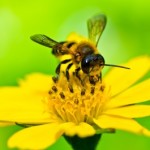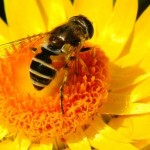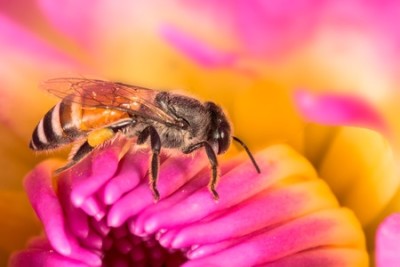TOXIC NEONICOTINOIDS ARE IN OUR AIR
New studies reviewed by Buglife show neonicotinoids are being widely spread, through the air and water, into hedgerows, meadows, rivers and ponds, where they can damage a great range of wildlife.
 The discovery of neonicotinoid insecticides in wildflowers, including Hogweed and Poppy pollen (up to 86ppb and 64ppb respectively), has heightened concern about the scale of environmental harm being caused by these agrotoxins. Not only are wild pollinators likely to be impacted, indeed honeybees in the study were collecting enough neonicotinoids to damage the productivity and reproduction rate of the hive, many other caterpillars and bugs living near arable fields are being exposed to toxic levels of the pesticides.
The discovery of neonicotinoid insecticides in wildflowers, including Hogweed and Poppy pollen (up to 86ppb and 64ppb respectively), has heightened concern about the scale of environmental harm being caused by these agrotoxins. Not only are wild pollinators likely to be impacted, indeed honeybees in the study were collecting enough neonicotinoids to damage the productivity and reproduction rate of the hive, many other caterpillars and bugs living near arable fields are being exposed to toxic levels of the pesticides.
Botias et al 2015 found higher concentrations of neonicotinoids in wild flowers in field margins than in Oilseed rape flowers in the adjacent neonicotinoid treated crop – on average 15ppb vs. 3ppb. They also found that more than 97% of the neonicotinoids being brought into the hive by honeybees were from wild flowers, only 3% from the crop.
Matt Shardlow, Chief Executive of Buglife said. “For many years Buglife has been raising concerns that neonicotinoids are likely to be following a pathway through margins and hedgerows into herbivores such as butterflies, moths, sawflies and bugs. Earlier this year a paper was published linking the decline of Monarch butterflies in the USA to neonicotinoids in field margins. The new University of Sussex research makes it clear that eye wateringly high concentrations of deadly insecticides have been frequent in hedgerow plants in the UK and it seems highly likely that this has been damaging the populations of hundreds of wild insects.”
This study comes on the heels of a Canadian study which found huge levels of neonicotinoids in the surface dust of arable fields and evidence that this dust blows into adjoining fields contaminating them and putting surface living predatory beetles at risk.

Planting flower rich field margins has been promoted by pesticide companies and the Government as a solution to the pollinator crisis and widely implemented supported by agri-environment funding. Last December work by Plymouth University showed that bumblebees preferred roadside verges to field margins, then this July work by Sussex University and the Game and Wildlife Conservation Trust showed that field verges helped bumblebees, but were of very limited value to the hundreds of species of solitary bees and other pollinators, now this study has shown that the margins can be heavily contaminated with insecticides.
Matt Shardlow added. “While flower-rich arable margins doubtlessly provide some succour to bumblebees and honeybees, they do not help solitary bees, or provide nesting habitats, nor do they help herbivores such as moths, leaf beetles and bugs as the habitat is often ploughed or sprayed off with herbicides before they complete their lifecycle. The restoration of wildflower meadows to create corridors of quality pollinator habitats, as proposed and guided by the national B-Lines scheme remains the strategy most likely to halt and reverse the loss of pollinators and grassland biodiversity.”
FACT BOX:
Buglife-The Invertebrate Conservation Trust is the only charity in Europe devoted to the conservation of all invertebrates, and is actively working to save Britain’s rarest bugs, bees, butterflies, ants, worms, beetles and many more fascinating invertebrates. Further information is available on Buglife’s website at www.buglife.org.uk, follow us on Twitter @buzz_dont_tweet and ‘Like us’ on Facebook: Buglife – The Invertebrate Conservation Trust

